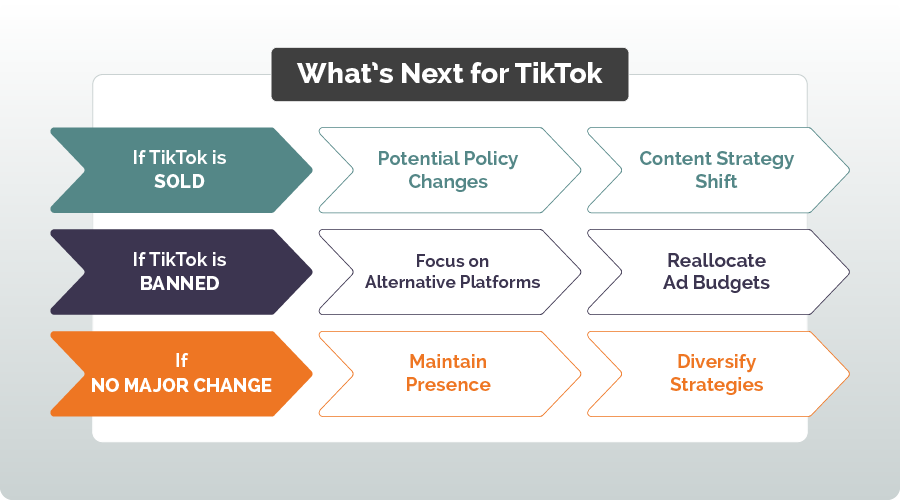Social Media giant, TikTok, has been a massive force for brands, creators, and users — but its future in the U.S.? Still hanging in the balance.
With rising government pressure, ByteDance faces a major decision: sell TikTok’s U.S. operations or risk a nationwide ban. For social media marketers, this poses a critical question: What’s next for your brand’s strategy?
No stress — we’ve got you covered. Let’s break down what’s happening, what it means for your marketing plans, and how to stay prepared in this rapidly changing landscape.
Background: Why is TikTok Being Forced to Sell?
Security Concerns at the Core
The U.S. government’s primary concern? Data privacy and national security. TikTok’s parent company, ByteDance, is based in China, sparking fears that American user data could be accessed by the Chinese government. This includes sensitive data like:
- 📍Location tracking
- 📊User preferences
- 👁️Biometric data
This isn’t a brand-new issue. Several incidents have only intensified scrutiny:
- Journalist data tracking raised alarms about surveillance.
- Content moderation practices were questioned for potential foreign influence.
Government Action and Legal Battles
In response to these concerns, Congress passed the Protecting Americans from Foreign Adversary Controlled Applications Act in April 2024. This law mandates that ByteDance sell TikTok’s U.S. operations by January 19, 2025 — or face a complete ban.
While ByteDance fought back with legal challenges, U.S. courts stood firm:
- December 2024: A U.S. federal appeals court upheld the divestment order.
- January 17, 2025: The U.S. Supreme Court confirmed the ruling.
However, in a surprising move, President Donald Trump issued an executive order on January 20, 2025, granting a 75-day extension to allow more time for negotiations. The new deadline? April 5, 2025.
Who Could Buy TikTok’s U.S. Operations?
The Elon Musk Buzz
One of the more surprising twists? Speculation that Elon Musk might enter the game. Reports suggest that Chinese officials are exploring a deal where Musk’s X (formerly Twitter) could take control of TikTok’s U.S. branch.
Why Musk?
- His existing ties with China through Tesla could smooth out diplomatic roadblocks.
- His experience with data-centric platforms aligns with TikTok’s algorithm-driven model.
Still, this is all speculation — nothing official yet.
Other Big-Name Contenders
It’s not just Musk in the mix. More traditional tech giants could step forward:
- Microsoft and Oracle, both of which were involved in past TikTok acquisition talks, may reconsider their bids.
But closing a deal of this scale isn’t simple. Major challenges include:
- Securing approval from U.S. and Chinese regulators
- Integrating TikTok without alienating its massive user base
- Balancing the geopolitical tensions that come with this sale
Reid Rasner’s $47.45 Billion Bid
In a bold move, U.S. entrepreneur Reid Rasner submitted a $47.45 billion offer on February 19, 2025, to acquire TikTok’s U.S. operations from ByteDance. Rasner’s plan includes:
- Relocating TikTok’s U.S. headquarters to Wyoming
- Creating high-paying jobs
- Boosting Wyoming’s economy
This offer adds a fresh angle to the ongoing negotiations and introduces a less conventional player into the mix. While Rasner might not have the tech industry clout of competitors like Microsoft or Oracle, his bid highlights the growing interest in securing TikTok under American ownership.
What Does This Mean for Users, Creators, and Brands?
For TikTok Users
- Platform Stability: Users could face temporary disruptions during the transition.
- Policy Shifts: New ownership might alter content guidelines, moderation practices, or introduce new features.
- Data Privacy: There may be changes in how user data is stored and managed to comply with U.S. regulations.
For TikTok Creators and Advertisers
- Monetization Uncertainty: Shifts in algorithms or monetization tools could impact creator earnings.
- Audience Shifts: A change in ownership might affect user demographics or how content is promoted.
- Brand Safety: Advertisers will be watching closely to ensure the platform remains a secure and effective channel.
For ByteDance
- Financial Losses: Losing TikTok’s U.S. market could significantly impact ByteDance’s bottom line.
- Strategic Setbacks: The company may need to refocus on its other platforms, like Douyin (China’s version of TikTok) and Lemon8, to recover lost ground.
The Bigger Picture: Social Media and Digital Marketing
Competitors on High Alert
If TikTok gets banned or even just disrupted, expect rival platforms to swoop in:
-
- Instagram Reels
- YouTube Shorts
- Snapchat Spotlight
- BlueSky
Emerging social platforms might also see a spike as users look for alternatives.
Shifting User Behavior
- Content Creators: May diversify their content across platforms to avoid losing their audiences.
- Brands: Could reallocate ad budgets toward platforms that feel more stable in the long run.
Global Ripple Effects
- Other countries might take cues from the U.S., potentially tightening regulations on foreign-owned apps.
- Europe and other regions could see new debates around data privacy and tech governance.
What’s Next for TikTok?
Three Possible Scenarios
- Successful Sale: ByteDance finds a buyer before the new April deadline.
- Restructuring: TikTok tweaks its U.S. operations to avoid a full sale.
- Full Ban: If no deal is made, TikTok could be blocked entirely in the U.S.
If TikTok Gets Banned...
- Creators would lose a massive platform, forcing them to focus on Instagram, YouTube, or newer social platforms.
- Brands would need to shift marketing efforts and ad spend elsewhere.
- ByteDance would face a significant financial hit and a blow to its global influence.
What Happens Under New Ownership?
If TikTok is sold, expect:
- Updates to the algorithm and monetization models
- Possible integration with the buyer’s existing platforms
- A heavier focus on data security to align with U.S. regulations
How Social Media Marketers Should Prepare
Rethinking your social media strategy is essential as TikTok’s future in the U.S. remains uncertain. Start by auditing your brand’s current presence — how much does your strategy rely on TikTok? Identify gaps and consider where your audience might go if TikTok is banned or undergoes significant changes.
Diversifying your content across different social platforms is key. Strengthen your efforts on Instagram Reels and YouTube Shorts, and don’t hesitate to explore emerging platforms that could gain popularity. Niche spaces like Pinterest and Snapchat also offer great opportunities for short-form video content. Most importantly, stay informed and adaptable. This situation is still developing, and being flexible will ensure your brand can pivot quickly as new updates unfold.
If you’re unsure where to start, Zero Gravity Marketing is here to help. Our team specializes in building agile strategies that keep your brand ahead — no matter how the social media landscape changes.
FAQs













